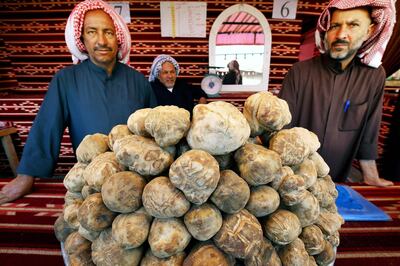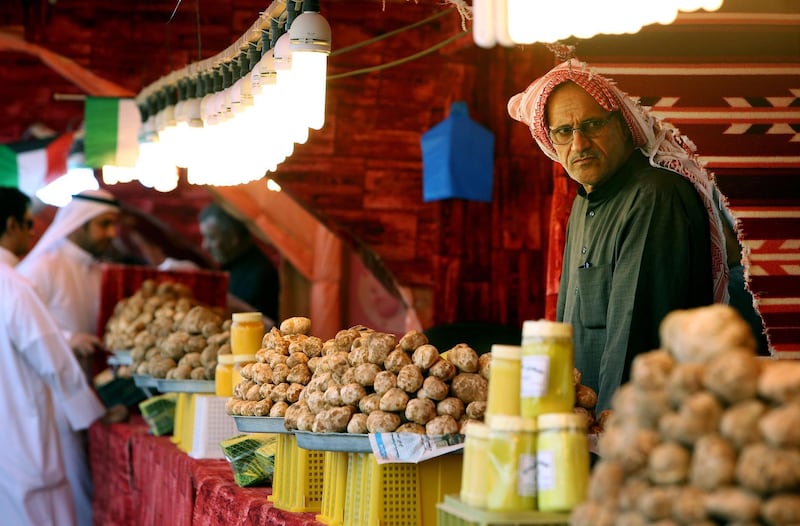White or beige, but never black, the "desert truffle" is a rare delicacy with a dedicated marketplace in Kuwait, where remnants of the Iraqi invasion and changing weather patterns have decimated local production.
Less prestigious and less expensive than its darker cousin, the Middle Eastern truffle is a prized ingredient for Bedouins, who integrate it into rice and meat dishes or in sauces, boiled with onions.
On the outskirts of Kuwait City, in the Rai industrial district, connoisseurs begin perusing the truffle souq at 9am, surveying the various weights and colours and using their noses to select the best fungus by smell.
Some barter while others go straight for the top shelf, with the Zebidi variety especially prized for use in traditional recipes.
Demand is so high in Kuwait that each year hundreds of merchants compete for limited stall space during the cooler winter months.
The market was devised by the municipality of Al Rai, an industrial zone just north-west of Kuwait City, which oversees quality control and guarantees the traceability of the fungus.
"We decided to build this market in 2006 to organise sales of this product, which you used to find in all sorts of corners in Kuwait," said Faisal Al Jomaa, vice governor of Kuwait City.
This year, he said, 520 merchants applied for one of the nine-square-metre stalls. Just 123 vendors secured space.
One of them was Abdel Ali Said, an Iranian who has bought and sold truffles since the 1960s.
"They come from Iran, Saudi Arabia, Morocco, Tunisia, Libya and beyond," he said of his truffle selection.
Prices range from seven to 20 Kuwaiti dinars (Dh85-244) a kilo, depending on the quality, he said.
This year, the market is flooded with truffles from Libya.
"That happens every six years," said Kuwaiti merchant Mohammed Al Shammari. "Production is cyclical. You also have a lot coming from Tunisia this year".
Underlining just how popular truffles are among Kuwaitis, Mr Al Shammari said "three to four tonnes are imported daily, and sold fresh".

But for all its love of truffles, Kuwait's own commercial cultivation and harvesting of the fungus has plummeted to zero since the invasion by Iraq in 1990.
The risk of coming across an unexploded landmine left behind by the Iraqi army keeps Kuwaitis from scouting the desert for wild truffles.
The only remaining production is purely for personal consumption.
Kuwait's truffle crops have also been hit by a changing environment.
Unlike European truffles, which grow under tree roots, desert truffles spring up after rain, which means that volume and quality vary according to the amount of precipitation and the general weather.
"Irregular rainfall, rapid urbanisation and encroachment on the desert are all factors" in the disappearance of local truffles, said Mr Al Jomaa, the Kuwait City official.
That has only increased desire for the delicacy, especially for making kabsa, the spiced rice speciality common throughout the Gulf and the most popular dish in Kuwait.
The main ingredients are long grain rice, red meat and truffles, used to flavour the broth while cooking.
"Kuwaitis are addicted to truffles because they are rare and have such a distinct taste," said Yousef Mohammed Al Khaled, a young truffle aficionado, who claims he can distinguish between various sub-varieties.
Mr Al Khaled said he spent up to 3,000 Kuwaiti dinars each year on white truffles, which he adds into meals twice a week, including family lunches on Thursdays, the last day of the work week.
Fresh truffles are only available from November to April in Kuwait, but some vendors sell a dried variation of the delicacy during the summer months in a bid to meet their customers' cravings all year round.
_______________
Read more:
[ My key ingredient: truffle pesto ]
[ Celebrate French food in the UAE as Taste of France returns ]
_______________





